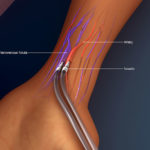WHICH AREA ARE YOU CONCERNED ABOUT?
Understanding the cardiovascular system and how it effects your overall health is important. We believe the more informed you are about the different types of vascular diseases, including the causes, risk factors and symptoms, the better equipped you will be in making the right health decisions.
Use the body on the right to click and receive more information about a particular area or to schedule an appointment.

Peripheral Artery Disease (PAD)
Peripheral artery disease occurs when there’s a narrowing or blockage of an artery in the leg resulting in reduced blood flow, sometimes causing pain or cramping when walking or exercising. This hardening of the artery (atherosclerosis) is a buildup of plaque inside the artery which over time can cause heart attacks, strokes, gangrene and even amputation. The main risk factors for PAD include a family history, an inactive lifestyle, smoking, diabetes, high cholesterol and high blood pressure.

Carotid Artery Disease
The carotid arteries are two of the four arteries in the neck that deliver blood and oxygen to the brain. When these arteries narrow (usually from the buildup of plaque) they reduce blood flow to the brain, which could result in a stroke. There are several factors that can increase your risk for carotid artery disease including genetics, high blood pressure, high cholesterol, smoking, diabetes, obesity and lack of exercise. The condition often doesn’t present any signs or symptoms until it progresses enough to cause a stroke or “mini-stroke” (TIA).

Abdominal Aortic Aneurysm (AAA)
Aneurysms are an abnormal widening of an artery. As the aneurysm grows over time, the arterial wall gets thinner and weaker with more of a chance that it will rupture. Aneurysms can occur anywhere in the body, the most common being in the aorta, the largest blood vessel in the body running from your heart through your chest and abdomen. AAAs typically grow slowly without symptoms, though sometimes you may notice constant pain in your abdomen or back along with a pulse near your bellybutton. Some risk factors of an AAA include a family history, age, smoking, being male and white.

Chronic Venous Insufficiency (CVI) & Varicose Veins
Over 40% of Americans have Chronic Venous Insufficiency which occurs when the valves inside the leg veins become incompetent or fail, making it difficult for blood to return to the heart from the legs. This leads to increased pressure (reflux) causing other connecting veins to bulge, stretch and become varicose veins. Common signs of CVI include swelling in the lower legs and ankles, as well as leg pain, fatigue, itching, cramping, skin discoloration and ulcers. There are many risk factors, the most important being a family history, obesity, pregnancy, inactivity, smoking, being female and over the age of 50.

Hemodialysis Access – Arteriovenous Fistula (AVF)
When the kidneys fail, hemodialysis is necessary to replace the function of the kidneys. In order to receive hemodialysis, vascular access must be created and maintained. An arteriovenous fistula is one of the main ways this is achieved. An AVF connects a vein to an artery allowing the vein to enlarge and get thicker. This provides the best method for dialysis as there are no foreign bodies thus reducing the risk of infection and increasing longevity of the access.

Hemodialysis Access – Central Venous Catheter
When the kidneys fail, hemodialysis is necessary to replace the function of the kidneys. In order to receive hemodialysis, vascular access must be created and maintained. Hemodialysis usually starts with a catheter, which is a doubled plastic tube that is inserted into a large vein in your neck near your heart. This allows immediate access however it is a temporary solution as it can be problematic if used over a long time period.






